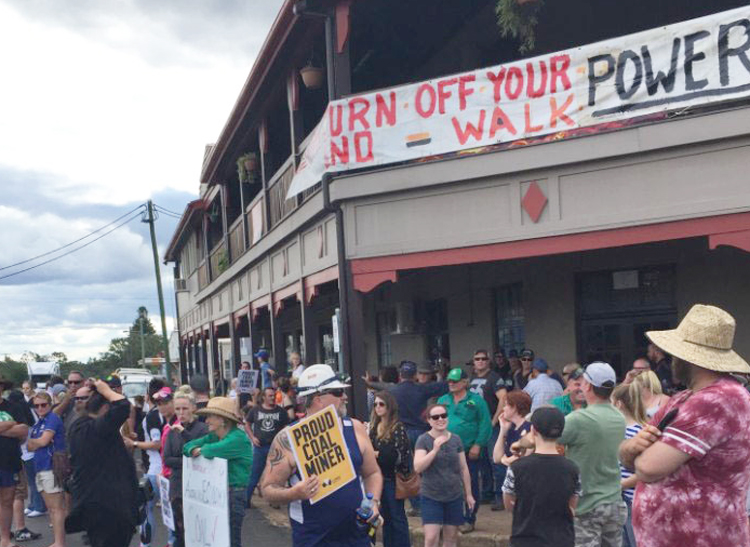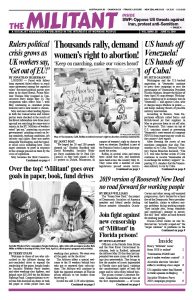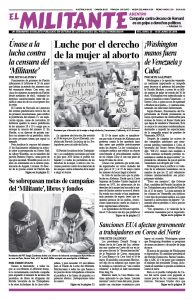SYDNEY — The conservative Liberal-National coalition government of Prime Minister Scott Morrison, widely predicted by liberal pundits to lose the election, defied the polls and won May 18. Most had expected a comfortable win for the opposition Labor Party led by Bill Shorten, a former top union official.
A column by Greg Sheridan in the May 20 Australian noted the similarities with Donald Trump’s victory in the 2016 U.S. presidential election, the Brexit referendum in the U.K. that year, and the yellow vest protests in France more recently. “The academics and the public broadcasters are sure they have changed society forever,” the conservative commentator opined, “only to find the peasants are revolting.”
Working people here face stagnant wages, spiraling costs of living and growing household debt. Economic slowdowns in China — the Australian bosses’ main trading partner — and elsewhere are threatening to end almost three decades of capitalist expansion. One key dilemma for Australia’s rulers is that even as they accelerate subsidized investment in renewable energy, coal still supplies 60% of the country’s electricity generation and is their top export. For working people here, electricity rates are the highest in the world, two to three times those in the U.S.
Crisis of Labor Party

Labor and the Greens gained votes in metropolitan inner-city areas, where growing numbers of young, better-paid professionals cluster. But the Labor vote fell in working-class suburbs, where families struggle to pay mortgages, and in the coal-mining regions of central Queensland and the Hunter Valley region north of Sydney.
A 2010 internal Labor Party report noted that the party faced the same fix as its European counterparts, with its support “devoured by Green or left-leaning parties on the one hand” and “right-wing populist parties” on the other. Compounding this, the union officialdom backing Labor heads a movement that now only represents 10% of workers in private industry, a consequence both of massive growth of temp and contract jobs and of the decadeslong class-collaborationist course of the union officialdom.
Shorten elevated Labor’s “climate change” focus into a “defining issue” in the elections. He set a goal of 45% cuts in carbon emissions by 2030, almost double the current government’s target. Labor proposed to fund this through higher taxes on layers of the working and middle classes, which were far from popular with working people.
A major controversy during the elections was a proposed giant coal mining development in central Queensland. Environmentalists, including some from Labor, waged a campaign to stop the mine being built by Indian conglomerate Adani.
Bob Brown, founder of the pro-capitalist Greens, led a “stop-Adani” convoy up the east coast of the country. In Clermont, the town closest to the proposed mine site, the convoy was met April 28 by a counterprotest of unemployed miners and other workers from the area. The project promises thousands of construction and mining jobs.
There are real environmental issues posed from despoliation of the countryside by open pit mining, as the profit-driven Adani bosses propose. Farmers are concerned over groundwater pollution.
Working people in the region, hard hit by drought, floods and unemployment, largely support the mine and the jobs it would bring. Labor was trounced at the polls there.
After the embarrassing electoral defeat, Anthony Albanese replaced Shorten as the Labor opposition leader, saying he would drop the anti-business rhetoric. “Unions and employers have a common interest,” he claimed.
Independent working-class road
In the lead up to the elections, members of the Communist League knocked on doors in working-class areas to pose the need to break with all the pro-capitalist parties.
Voting in Australia is compulsory. “I just voted so I don’t have to pay the fine,” Branco Jazic, a construction worker, told CL members. “It doesn’t make a difference who I vote for.” Many made comments like this, reflecting the distrust and aversion that growing numbers of working people have for all the capitalist political parties in Canberra.
In regional Australia and Queensland many workers voted for minor parties as a protest. These votes mainly went to parties on the right — like Pauline Hanson’s One Nation and the United Australia Party — both of which backed building the Adani mine. Greens leader Brown blamed working people for the election outcome, saying their “greed won” out over “morality.”
“What working people need today is organize the unorganized, to rebuild our unions and transform them into fighting instruments,” Communist League campaign spokesperson Manuele Lasalo told the Militant May 21. “We need to build a labor movement and our own party independent from the bosses, their state and their political parties.”

